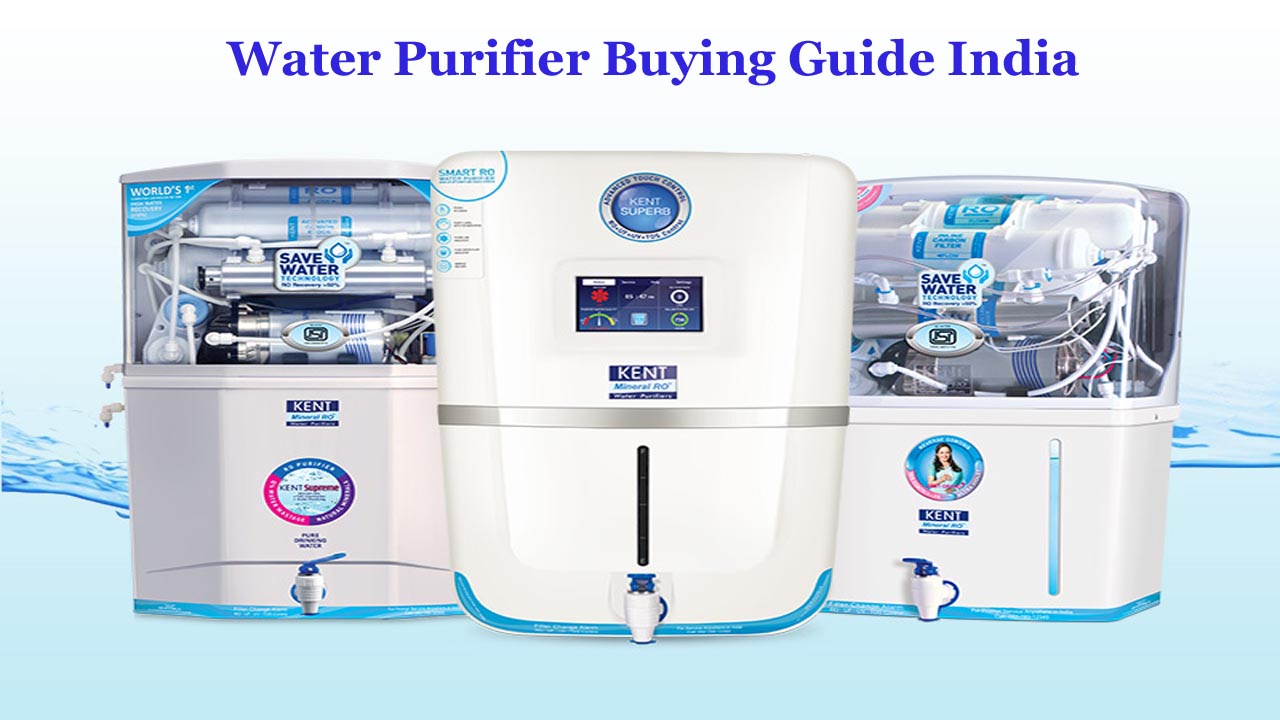Want to get the best Water Purifier Guide India? You can get useful information in this blog on things to consider while purchasing a water purifier in India.
While searching for the best water purifiers, What are the essential features to look for.
Because of the increasing contamination of water sources, water purifiers have become necessary in India. However, given the numerous options on the market, selecting the best water purifier can take time and effort. This buying guide will discuss some important factors to consider when purchasing a water purifier in India.
Which water purifier are you looking to purchase? This is likely to be the first question a salesperson asks, or it comes to mind when you consider purchasing a water purifier.
This can be a very perplexing question if you are still familiar with the various types of water purifiers available offline or online.
This blog contains helpful information on the factors to take into account while buying a water purifier in India.
Water purifiers are classified into several types based on their features, filter type, and brand.
To Read: Best Kent Water Purifier Review.
How to choose the right water purifier
Water Quality:
The quality of the water in your location should be taken into account initially. You can obtain a water quality report from your municipality or test it at a laboratory. This will help you understand the contaminants in your water and select a purifier that can effectively remove them.
Storage Capacity:
Another important factor to consider is the water purifier’s storage capacity. A purifier with a larger storage capacity may be required if you have a large family. If you have a small family or live alone, a purifier with a smaller storage capacity may be adequate.
Maintenance and After-Sales Service:
It is critical to choose a water purifier that is simple to maintain and comes with excellent after-sales support. Examine the brand’s reputation for customer service and the availability of spare parts. Water purifiers that have been certified by independent organizations such as NSF International or the Water Quality Association are preferable. These certifications ensure that the purifier meets certain water purification standards.
Budget:
Because water purifiers come in various price ranges, it is critical to plan ahead of time. Keep in mind that a more expensive purifier may only sometimes be superior to a less expensive one. Therefore, before making a choice, consider the features and benefits of each purifier.
Additional Features:
Some water purifiers include extra features such as a water level indicator, filter change indicator, and auto shut-off. These features make the purifier easier to use and maintain.
We will go over each purifier one by one.
Type of Purifiers:
Water purifiers are classified primarily by the type of filter used inside them. Inside the purifier, six different types of water filters are typically used. Therefore, water purifiers are classified into five categories based on the type of filter used.
1. Sediment water purifiers:
Sediment water purifiers are those that filter water by removing sediment and other bigger particles. Sediment is any solid particles found in water, such as sand, dirt, rust, and other debris. Sediment water purifier’s work by passing water through a series of filters typically made of materials such as sand, gravel, or activated carbon, which trap and prevent sediment particles from passing through. These purifiers are typically used as a pre-treatment step before other water purification methods, such as reverse osmosis or UV treatment. The advantages of using a sediment water purifier include improved water clarity, reduced clogging risk in other water treatment systems, and improved water taste and odor. However, sediment water purifiers are ineffective at removing bacteria, viruses, and other microscopic contaminants that may be present in the water. To check that the water is safe to consume, additional water purification techniques like UV treatment or chlorination are necessary.
2. Activated carbon water purifiers:
Activated carbon water purifiers are a type of water treatment technology that removes impurities & contaminants from water by using activated carbon. Activated carbon is a highly porous material that has been treated with oxygen to form thousands of tiny holes between carbon atoms, resulting in a large surface area for impurity adsorption. Water is passed through an activated carbon water purifier filter, which traps and removes contaminants such as chlorine, pesticides, industrial solvents, and other chemicals that can affect drinking water’s taste, odor, and safety. Activated carbon also effectively removes certain volatile organic compounds (VOCs) from water. The benefits of using activated carbon water purifiers include improved water taste and odor, removal of certain chemicals and impurities, as well as low cost and ease of use. To ensure that the water is safe to drink, activated carbon filters may need to be used in conjunction with other water treatment techniques like reverse osmosis or UV treatment as they may not be able to completely remove all contaminants, including bacteria and viruses. Overall, activated carbon water purifiers are a dependable and effective water treatment option for improving the quality and safety of drinking water, particularly for those concerned about the taste and odor of their water or who want to limit their exposure to certain toxins.
3. Ultraviolet (UV) water purifiers:
Ultraviolet (UV) water purifiers are a type of water purification system that uses UV radiation to kill or deactivate harmful microorganisms found in water, such as bacteria, viruses, and protozoa. UV water purifiers effectively remove biological contaminants from water and are frequently used as the final step in the water treatment process. UV water purifiers work by exposing the water to UV light, which damages the DNA of microorganisms, preventing them from reproducing and killing them. UV light is typically generated by a UV lamp enclosed in a quartz glass sleeve in these purifiers. The fact that UV water purifiers do not utilise chemicals or other additions to clean the water is one of its main advantages. They also require little maintenance and are efficient at getting rid of a range of germs. However, it should be noted that UV water purifiers are ineffective at removing other contaminants from water, such as chemicals or sediment. As a result, further water purification techniques, like reverse osmosis or activated carbon filters, are needed to guarantee that the water is safe to drink.
4. Ultrafiltration (UF) water purifiers:
Ultrafiltration (UF) water purifiers are water purification systems that remove impurities from water using a membrane. Because UF membranes have small pore sizes (typically 0.01 to 0.1 microns), they can remove bacteria, viruses, and other contaminants from water. Under pressure, UF water purifiers work by forcing water through a membrane. The membrane functions as a physical barrier, allowing water molecules to pass while trapping larger particles and microorganisms. Purified water is collected on one side of the membrane, while impurities are flushed out on the other. The capacity of UF water purifiers to eliminate a variety of pollutants from water, including bacteria, viruses, and protozoa, is one of their main advantages. Since they don’t utilise chemicals or other additions to cleanse the water, they are also low-maintenance. On the other hand, UF water purifiers may be ineffective at removing dissolved solids or chemicals from water. Further water purification techniques, like reverse osmosis or activated carbon filters, are needed to guarantee that the water is safe to drink.
5. Reverse osmosis (RO) water purifiers:
RO water purifiers are a type of water purification system that removes impurities from water using a semipermeable membrane. The RO membrane has small pores ranging from 0.0001 to 0.001 microns, allowing it to remove dissolved salts, minerals, heavy metals, and other contaminants from water.RO water purifier’s work by forcing water under pressure through a membrane. The membrane functions as a physical barrier, allowing water molecules to pass while trapping larger particles and impurities. As a result, purified water is collected on one side of the membrane, while impurities are flushed out on the other. One of the primary benefits of RO water purifiers is their ability to remove a wide range of contaminants from water, including dissolved solids, salts, minerals, heavy metals, and other impurities. Since they don’t utilise chemicals or other additions to cleanse the water, they are also low-maintenance. However, RO water purifiers may remove beneficial minerals from the water, affecting its taste and quality. As a result, it is critical to select a RO water purifier that includes a mineral cartridge to replenish beneficial minerals in the purified water.
6. Alkaline Water Purifier:
Alkaline water purifiers are a type of water purification system that uses electrolysis to raise the pH of the water and make it more alkaline. To produce alkaline water, these purifiers typically employ a combination of carbon filtration, ion exchange, and electrolysis. The carbon filter removes impurities and chlorine from the water, whereas the ion exchange system removes minerals like calcium and magnesium, contributing to water hardness. The water is then passed through an electrolysis chamber, which separates the water molecules into acidic and alkaline components using a small electric current. These purifiers typically produce alkaline water with a pH level of 8 to 9, which is slightly higher than the neutral pH level of 7. Alkaline water supporters claim that it has numerous health benefits, including improved digestion and increased energy levels. However, there needs to be more scientific evidence to back up these claims. It is also crucial to remember that alkaline water purifiers do not eliminate all toxins from the water, including viruses and bacteria.
As a result, additional water purification methods, such as UV treatment or reverse osmosis, are required to ensure that the water is safe to drink. Furthermore, people with certain medical conditions, such as kidney disease, should consult with a doctor before drinking alkaline water.
Conclusion
Finally, selecting the right water purifier can help you and your family have access to clean and safe drinking water. When purchasing, consider the factors discussed above and select the purifier that best meets your needs and budget. The dependability of the water purification process may be increased and the water can be made free of all types of contaminants by using these water filters alone or in combination with the other filters.

